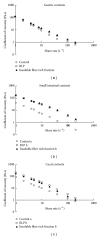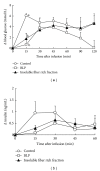Insoluble fiber in young barley leaf suppresses the increment of postprandial blood glucose level by increasing the digesta viscosity
- PMID: 24348688
- PMCID: PMC3857754
- DOI: 10.1155/2013/137871
Insoluble fiber in young barley leaf suppresses the increment of postprandial blood glucose level by increasing the digesta viscosity
Abstract
Barley (Hordeum vulgare L.) is a well-known cereal plant. Young barley leaf is consumed as a popular green-colored drink, which is named "Aojiru" in Japan. We examined the effects of barley leaf powder (BLP) and insoluble fibers derived from BLP on postprandial blood glucose in rats and healthy Japanese volunteers. BLP and insoluble fibers derived from BLP suppressed the increment of postprandial blood glucose levels in rats (P < 0.01), and increased the viscosity of their digesta. The insoluble fibers present in BLP might play a role in controlling blood glucose level by increasing digesta viscosity. In human, BLP suppressed the increment of postprandial blood glucose level only in those which exhibited higher blood glucose levels after meals (P < 0.01). BLP might suppress the increment of postprandial blood glucose level by increasing digesta viscosity in both of rats and humans who require blood glucose monitoring.
Figures







Similar articles
-
Consumption of a meal containing refined barley flour bread is associated with a lower postprandial blood glucose concentration after a second meal compared with one containing refined wheat flour bread in healthy Japanese: A randomized control trial.Nutrition. 2020 Apr;72:110637. doi: 10.1016/j.nut.2019.110637. Epub 2019 Nov 9. Nutrition. 2020. PMID: 31951932 Clinical Trial.
-
A double-blind randomised controlled trial testing the effect of a barley product containing varying amounts and types of fibre on the postprandial glucose response of healthy volunteers.Br J Nutr. 2015 May 14;113(9):1373-83. doi: 10.1017/S0007114515000367. Epub 2015 Apr 8. Br J Nutr. 2015. PMID: 25850814 Clinical Trial.
-
Effects of young barley leaf powder on gastrointestinal functions in rats and its efficacy-related physicochemical properties.Evid Based Complement Alternat Med. 2014;2014:974840. doi: 10.1155/2014/974840. Epub 2014 Jul 8. Evid Based Complement Alternat Med. 2014. PMID: 25114709 Free PMC article.
-
Effect of processing on barley β-glucan content, its molecular weight and extractability.Int J Biol Macromol. 2020 Nov 1;162:1204-1216. doi: 10.1016/j.ijbiomac.2020.06.208. Epub 2020 Jun 25. Int J Biol Macromol. 2020. PMID: 32592782 Review.
-
Understanding the Physics of Functional Fibers in the Gastrointestinal Tract: An Evidence-Based Approach to Resolving Enduring Misconceptions about Insoluble and Soluble Fiber.J Acad Nutr Diet. 2017 Feb;117(2):251-264. doi: 10.1016/j.jand.2016.09.021. Epub 2016 Nov 15. J Acad Nutr Diet. 2017. PMID: 27863994 Review.
Cited by
-
Preventive and Therapeutic Role of Functional Ingredients of Barley Grass for Chronic Diseases in Human Beings.Oxid Med Cell Longev. 2018 Apr 4;2018:3232080. doi: 10.1155/2018/3232080. eCollection 2018. Oxid Med Cell Longev. 2018. PMID: 29849880 Free PMC article. Review.
-
High leafy and root vegetables and high rice dietary patterns were associated with primary and secondary bile acid levels in the feces.Sci Rep. 2025 Jan 15;15(1):2092. doi: 10.1038/s41598-025-86273-8. Sci Rep. 2025. PMID: 39814946 Free PMC article.
-
Impact of Six Extraction Methods on Molecular Composition and Antioxidant Activity of Polysaccharides from Young Hulless Barley Leaves.Foods. 2023 Sep 9;12(18):3381. doi: 10.3390/foods12183381. Foods. 2023. PMID: 37761090 Free PMC article.
-
Barley a nutritional powerhouse for gut health and chronic disease defense.Heliyon. 2024 Sep 28;10(20):e38669. doi: 10.1016/j.heliyon.2024.e38669. eCollection 2024 Oct 30. Heliyon. 2024. Retraction in: Heliyon. 2025 Mar 14;11(6):e43088. doi: 10.1016/j.heliyon.2025.e43088. PMID: 39640645 Free PMC article. Retracted. Review.
-
Redirecting barley breeding for grass production through genome editing of Photoperiod-H1.Plant Physiol. 2024 Apr 30;195(1):287-290. doi: 10.1093/plphys/kiae075. Plant Physiol. 2024. PMID: 38366881 Free PMC article.
References
-
- Ferreres F, Kršková Z, Gonçalves RF, et al. Free water-soluble phenolics profiling in barley (Hordeum vulgare L.) Journal of Agricultural and Food Chemistry. 2009;57(6):2405–2409. - PubMed
-
- Kamiyama M, Shibamoto T. Flavonoids with potent antioxidant activity found in young green barley leaves. Journal of Agricultural and Food Chemistry. 2012;60(25):6260–6267. - PubMed
-
- Kohyama N, Ono H, Yanagisawa T. Changes in anthocyanins in the grains of purple waxy hull-less barley during seed maturation and after harvest. Journal of Agricultural and Food Chemistry. 2008;56(14):5770–5774. - PubMed
-
- Ohtake H, Nonaka S, Sawada Y. Studies on the constituents of green juice from young barley leaves. Effect on dietarily induced hypercholesterolemia in rats. Yakugaku Zasshi. 1985;105(11):1052–1057. - PubMed
-
- Yu Y-M, Wu C-H, Tseng Y-H, Tsai CE, Chang W-C. Antioxidative and hypolipidemic effects of barley leaf essence in a rabbit model of atherosclerosis. Japanese Journal of Pharmacology. 2002;89(2):142–148. - PubMed
LinkOut - more resources
Full Text Sources
Other Literature Sources

